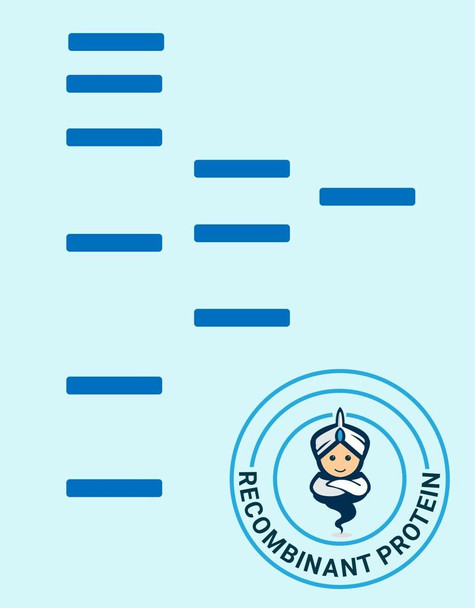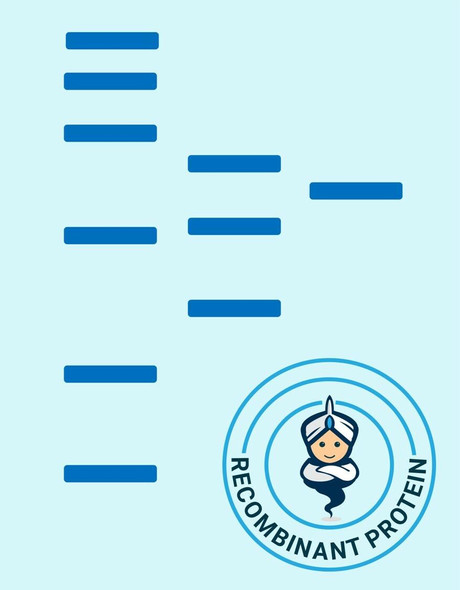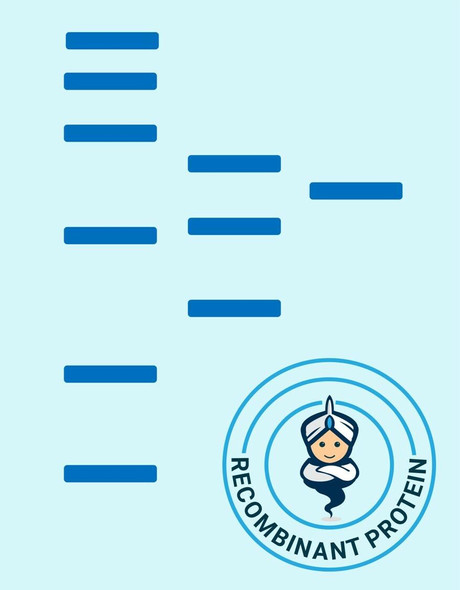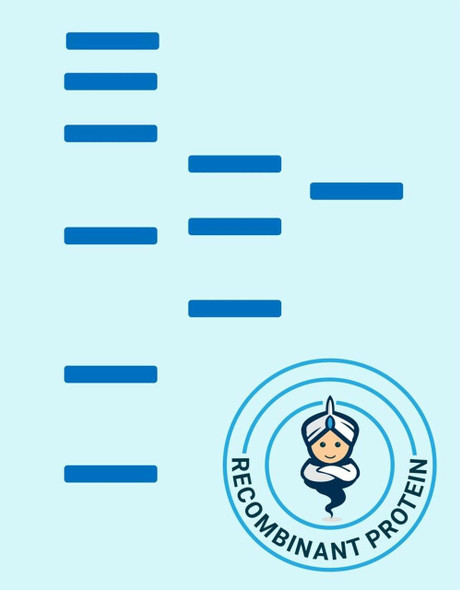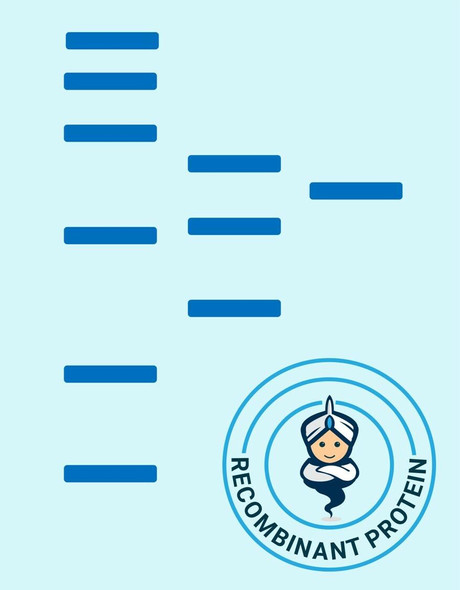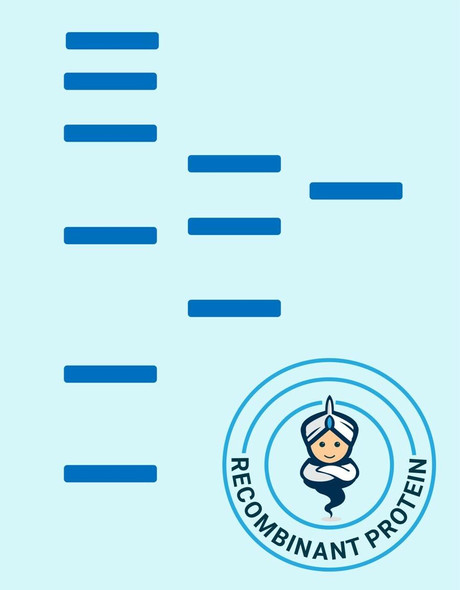Description
| Product Name: | Human AGA Recombinant Protein |
| Product Code: | RPPB1365 |
| Size: | 20µg |
| Species: | Human |
| Target: | AGA |
| Synonyms: | Aspartylglucosaminidase, AGU, ASRG, GA. |
| Source: | Escherichia Coli |
| Physical Appearance: | Sterile Filtered colorless solution. |
| Formulation: | AGA protein solution (0.5mg/ml) containing 20mM Tris-HCl buffer (pH 8.0) and 10% glycerol. |
| Stability: | Store at 4°C if entire vial will be used within 2-4 weeks. Store, frozen at -20°C for longer periods of time. For long term storage it is recommended to add a carrier protein (0.1% HSA or BSA).Avoid multiple freeze-thaw cycles. |
| Purity: | Greater than 90% as determined by SDS-PAGE. |
| Amino Acid Sequence: | MGSSHHHHHH SSGLVPRGSH MGSSSPLPLV VNTWPFKNAT EAAWRALASG GSALDAVESG CAMCEREQCD GSVGFGGSPD ELGETTLDAM IMDGTTMDVG AVGDLRRIKN AIGVARKVLE HTTHTLLVGE SATTFAQSMG FINEDLSTTA SQALHSDWLA RNCQPNYWRN VIPDPSKYCG PYKPPGILKQ DIPIHKETED DRGHDTIGMV VIHKTGHIAA GTSTNGIKFK IHGRVGDSPI PGAGAYADDT AGAAAATGNG DILMRFLPSY QAVEYMRRGE DPTIACQKVI SRIQKHFPEF FGAVICANVT GSYGAACNKL STFTQFSFMV YNSEKNQPTE EKVDCI |
Aspartylglucosaminidase, also known as AGA, takes part in the catabolism of Nlinked oligosaccharides of glycoproteins. AGA is a protein coding gene which cleaves asparagine from N-acetylglucosamines in the lysosomal breakdown of glycoproteins.
AGA Human Recombinant produced in E.Coli is a single, non-glycosylated polypeptide chain containing 346 amino acids (24-346 a.a.) and having a molecular mass of 37kDa.AGA is fused to a 23 amino acid His-tag at N-terminus & purified by proprietary chromatographic techniques.
| UniProt Protein Function: | AGA: a catabolic enzyme, aspartylglucosaminidase is involved in the catabolism of N-linked oligosaccharides of glycoproteins. It cleaves asparagine from N-acetylglucosamines as one of the final steps in the lysosomal breakdown of glycoproteins. The lysosomal storage disease aspartylglycosaminuria is caused by a deficiency in the AGA enzyme. |
| UniProt Protein Details: | Protein type:Glycan Metabolism - other glycan degradation; EC 3.5.1.26; Hydrolase Chromosomal Location of Human Ortholog: 4q34.3 Cellular Component: endoplasmic reticulum; lysosome Molecular Function:peptidase activity; N4-(beta-N-acetylglucosaminyl)-L-asparaginase activity; protein self-association Biological Process: protein deglycosylation; protein maturation; proteolysis Disease: Aspartylglucosaminuria |
| NCBI Summary: | Aspartylglucosaminidase is involved in the catabolism of N-linked oligosaccharides of glycoproteins. It cleaves asparagine from N-acetylglucosamines as one of the final steps in the lysosomal breakdown of glycoproteins. The lysosomal storage disease aspartylglycosaminuria is caused by a deficiency in the AGA enzyme. Alternatively spliced transcript variants have been identified. [provided by RefSeq, Jan 2010] |
| UniProt Code: | P20933 |
| NCBI GenInfo Identifier: | 288558804 |
| NCBI Gene ID: | 175 |
| NCBI Accession: | P20933.2 |
| UniProt Secondary Accession: | P20933,Q4W5Q2, Q6FHN6, Q9UCK6, Q9UCK7, Q9UCK8, B2R7H2 D3DP47, |
| UniProt Related Accession: | P20933 |
| Molecular Weight: | 346 |
| NCBI Full Name: | N(4)-(beta-N-acetylglucosaminyl)-L-asparaginase |
| NCBI Synonym Full Names: | aspartylglucosaminidase |
| NCBI Official Symbol: | AGA�� |
| NCBI Official Synonym Symbols: | GA; AGU; ASRG�� |
| NCBI Protein Information: | N(4)-(beta-N-acetylglucosaminyl)-L-asparaginase; N(4)-(beta-N-acetylglucosaminyl)-L-asparaginase; glycosylasparaginase; aspartylglucosylamine deaspartylase; N4-(N-acetyl-beta-glucosaminyl)-L-asparagine amidase |
| UniProt Protein Name: | N(4)-(beta-N-acetylglucosaminyl)-L-asparaginase |
| UniProt Synonym Protein Names: | Aspartylglucosaminidase; Glycosylasparaginase; N4-(N-acetyl-beta-glucosaminyl)-L-asparagine amidaseCleaved into the following 2 chains:Glycosylasparaginase alpha chain; Glycosylasparaginase beta chain |
| Protein Family: | Agaricus bisporus lectin |
| UniProt Gene Name: | AGA�� |
| UniProt Entry Name: | ASPG_HUMAN |

